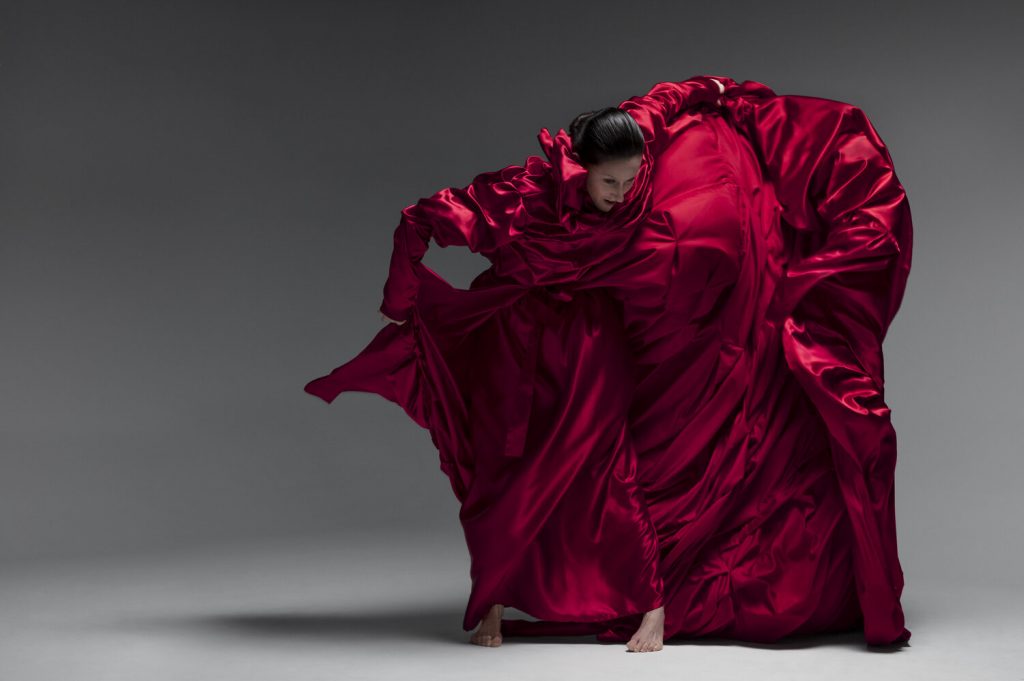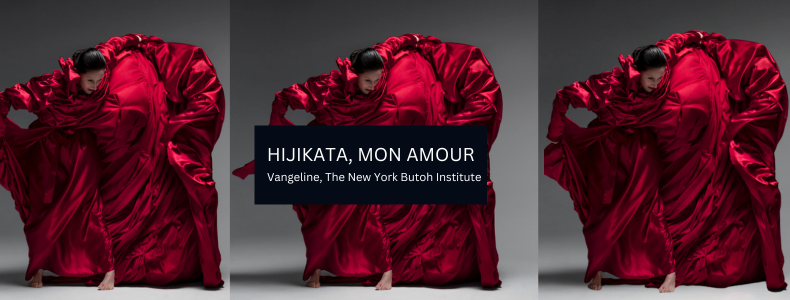VANGELINE, THE NEW YORK BUTOH INSTITUTE
VANGELINE, THE NEW YORK BUTOH INSTITUTE states that it “carries Butoh into the 21st century.”.
Visceral, Daring, Celestial
Created in 2019 in celebration of Butoh’s 60th anniversary. A tribute to Tatsumi Hijikata, the founder of Butoh. As part of their performance, Vangeline wears an exact replica of Tatsumi Hijikata’s 1968 costume, which Todd Thomas recreated for them. Todd Thomas’ stunning, startling red dress will delight fashion and art lovers alike.
Much like Butoh itself, it was born at the confluence of East and West. This costume chronicles the evolution of postmodern art in Japan, and as such, deserved to be carefully studied, and thrown into the limelight once again.
In 2019, thanks to a Janet Arnold Award of the Society of Antiquaries of London and a loan from the Tatsumi Hijikata Archives, Vangeline Theater/New York Butoh Institute researched how the costume was designed by recreating it. The costume was professionally photographed by Matthew Placeck.
Hijikata, Mon Amor joins Dance City on the 10th November at 7:30pm.
A brief history of Butoh
The art form of Butoh originated in Japan. After the Second World War, Butoh emerged as an avant-garde dance form characterised by sharp, erratic movements performed in a very slow, very controlled manner. Audiences are able to absorb the emotions of the movements more fully with slower movements.
“At times, they limp like the dead. The performers’ movements on stage can be very disturbing for first-time viewers. But once you get over it, you’ll find that the slow movements are on purpose.”
Harris, 2023
White paint and little or no hair are typically used in Butoh performances. As a result, the audience is stripped of any preconceived notions about the performers and given a sense of ‘childish purity’. It is also traditional for Butoh performances to be performed unrehearsed. Movements are supposed to be natural and spontaneous, which is the opposite of dance in westernised cultures. It is because of this spontaneity of movements that a Butoh performance can look different a second time. Although Butoh is a specific dance style, with certain moves and elements that make it recognisable, each dancer makes it their own using their own body, movement and life experiences to influence their practice – Butoh is individual, just like the performer who performs it.
Butoh is best known for being against every convention and custom that’s held dear in Japanese artistic standards, from the theme of the pieces to the costumes and the choreographies.
Harris, 2023

Fashion and costumes are a frequent reoccurrence in the performances of Vangeline and at The New York Institue of Butoh. Since its inception, Vangeline Theatre has held a special relationship to costume conservation. The dress in this performance is not just a costume or a prop, it is an integral display of emotion, moving as the body moves. The dress, an exact replica of the late sensei’s iconic attire worn in his legendary 1968 solo work, Revolt of the Body (Nikutai no Hanran), which was and remains a definitive moment in the history of butoh. The costume symbolises the female influence that happened to Butoh around 1966/68. Hijikata took on feminine mannerisms, grew his hair long, wore women’s clothing to perform and said that the spirit of his deceased sister danced inside of him.
Both Butoh and the striking ensemble openly play with themes of gender fluidity and androgyny vs normalcy and conformity; Eastern vs Western styles and ideas; the grotesque and macabre vs the beautiful and transcendent; and the point where the past meets the future while existing in the present moment.
“The biggest challenge was the beginning of the piece, which is so very slow, to the point where the human eye cannot detect movement. These types of movements are challenging to achieve. I cannot honestly say that I feel ‘triumph’, but I really enjoyed venturing outside of what I am familiar with, such as making the costume into a puppet and giving Hijikata a voice at the end of the show. I enjoyed bringing humor into the piece, such as the section with the hands. The piece had to be choreographed around the costume, with its twenty yards of fabric. It took 100 hours of rehearsals to learn to seamlessly move in this costume; it took time to find ways to incorporate the costume into the story. However, I probably still need another 100 hours to perfect the piece. It feels as though the work is never finished.”
Vangeline
An informal post show talk will take place after the performance in the atrium of Dance City. The talk will be with a member of the Dance City team, the Choreographer and members of the company. No booking for the post show talk is required.
Book your tickets for Hijikata, Mon Amour on Friday 10th November at 7:30pm.





